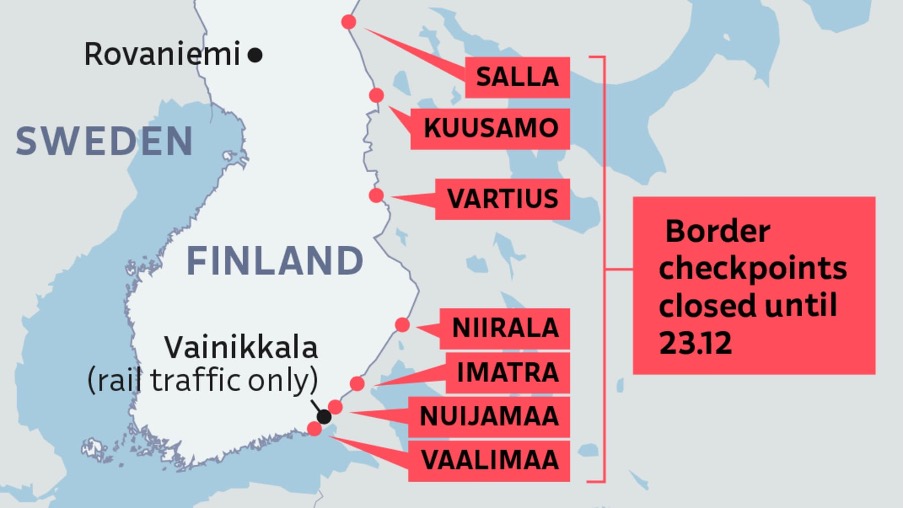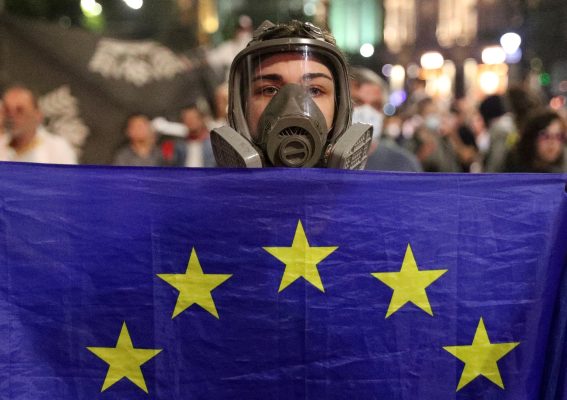We are back in October 2021, but in a new location.
This time it’s not the border between Poland and Belarus where there’s a sudden influx of developing world migrants, but on Finland’s 833-mile (1,340km) border with Russia.
Since August, around 900 asylum seekers have been waved through by Russian border control to the Finnish checkpoints without proper documentation.

Source: Image: Miku Huttunen / Yle https://yle.fi/a/74-20062056
The Kremlin’s officials have assisted vulnerable asylum seekers from countries such as Iraq, Afghanistan, Syria, Yemen, Morocco, and Somalia to reach the remote border stations of Finland, providing them with clothing and bicycles for the crossing. It is worth noting that asylum seekers from these countries had to have been granted Russian visas otherwise they would have been denied entry. There are also reports that Russian authorities are helping refugees to travel to Russia. While transported to the EU border, the asylum seekers are left without money or documentation.
The Finnish government has taken swift action, closing all nine border stations and as of 28 November. One frontier post in Lapland, the furthest north, is scheduled to reopen on December 13 and the other eight on 23 December, but clearly that may change according to the situation.
During 25-27 November, some 59 people made it to the remote checkpoint of Raja-Jooseppi in Lapland, showing Russia has no intention of slowing down the weaponization and exploitation of third-country nationals in distress. Asylum seekers can continue to apply for international protection at seaports or at Helsinki Airport.
Sweden’s Prime Minister Ulf Kristersson declared Sweden’s support for Finland’s stern border policies, pledging any help the Finnish authorities might require, which he characterized as bringing the Ukraine war closer to home.
The situation has been deemed critical by the Finnish Government and signals that national security considerations will take precedence over other international legal commitments, however difficult this may be.
The non-discrimination ombudsman has raised concerns about border controls seriously challenging the asylum seekers right to apply for international protection and may infringe on the principle of nonrefoulement and the ban of collective expulsion, both central principles in national and European Union (EU) law
Finland has however established two registration centers in Oulu and Joutseno, where the asylum seekers are obliged to stay until their applications have been processed. Since Russia does not allow asylum seekers to return to its soil, by this arrangement no asylum seekers will be left in the grey zone between Finland and Russia in temperatures below -20 to -30 Celsius, or be able to leave for another EU country unchecked.
The events of today resemble the migrant crisis of 2015-2016. Using the lessons learned then, Finland has been preparing for a repeat ever since. Procedures and legislation (extending civilian intelligence powers) to deal with the flow of illegal migrants and asylum seekers are in place and the border control, police, and defense forces are well prepared and rehearsed for any action needed.
Finland interprets Russia’s behavior as a hybrid attack, that is hostile action short of war, triggered by its strong support of Ukraine, the sanctions regime against Russia, and Finnish NATO membership. The anticipated consequences, including a sense of crisis and internal division (migrants are not universally welcome), can then be used to portray the country as anti-Russian and intolerant.
Russian officials are said to have told asylum seekers that should the Finnish border close altogether, they will be directed to the borders of Norway, Estonia, and Lithuania. The issue will therefore need to be addressed by the EU as a whole.
In her speech to the European Parliament on 21 November, Commissioner Ylva Johansson called for collective action and pledged support to Finland in securing and protecting the EU borders while upholding EU values. Frontex is assisting Finland with 50 border guards as part of the Frontex Joint Operations Terra 2023.
Russia’s behavior is both systematic and deliberate.
In the grand scheme of things, directing asylum seekers en masse to the borders of the EU is both a cheap and effective weapon to create internal mayhem in EU member states and in the EU decision-making apparatus.
Russia seeks to confuse the EU foreign policy agency with a third crisis, besides that of Ukraine and Gaza, by juxtapositioning national security against its core values. The hope is to thwart the energy, focus, and resources of the West, and to give room for geopolitical ambitions elsewhere, in Ukraine but perhaps even in the South China Sea and Taiwan.
This is why Russia is probably not going to stop anytime soon with its bullying tactics at its borders, and why Europe should be wide awake to nip these activities in the bud.
Charlotta Collén is a Non-resident Senior Fellow with the Transatlantic Defense and Security Program at the Center for European Policy Analysis (CEPA). She is a director, policy planner, and strategic thinker with experience in science policy, international affairs, diplomacy, and the security and defense domain. Collén has previously worked as a Senior Advisor in the Defence Policy Department of the Ministry of Defence (MoD) of Finland.
Europe’s Edge is CEPA’s online journal covering critical topics on the foreign policy docket across Europe and North America. All opinions are those of the author and do not necessarily represent the position or views of the institutions they represent or the Center for European Policy Analysis.





